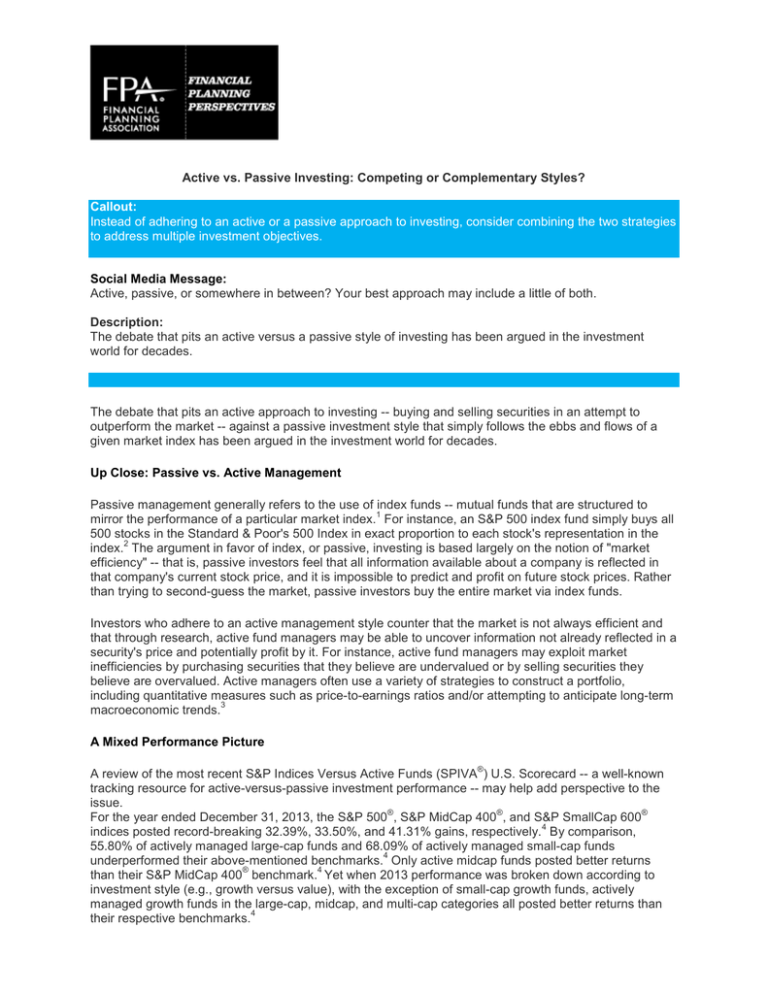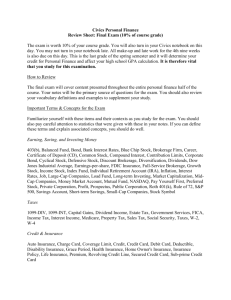
Active vs. Passive Investing: Competing or Complementary Styles?
Callout:
Instead of adhering to an active or a passive approach to investing, consider combining the two strategies
to address multiple investment objectives.
Social Media Message:
Active, passive, or somewhere in between? Your best approach may include a little of both.
Description:
The debate that pits an active versus a passive style of investing has been argued in the investment
world for decades.
The debate that pits an active approach to investing -- buying and selling securities in an attempt to
outperform the market -- against a passive investment style that simply follows the ebbs and flows of a
given market index has been argued in the investment world for decades.
Up Close: Passive vs. Active Management
Passive management generally refers to the use of index funds -- mutual funds that are structured to
1
mirror the performance of a particular market index. For instance, an S&P 500 index fund simply buys all
500 stocks in the Standard & Poor's 500 Index in exact proportion to each stock's representation in the
2
index. The argument in favor of index, or passive, investing is based largely on the notion of "market
efficiency" -- that is, passive investors feel that all information available about a company is reflected in
that company's current stock price, and it is impossible to predict and profit on future stock prices. Rather
than trying to second-guess the market, passive investors buy the entire market via index funds.
Investors who adhere to an active management style counter that the market is not always efficient and
that through research, active fund managers may be able to uncover information not already reflected in a
security's price and potentially profit by it. For instance, active fund managers may exploit market
inefficiencies by purchasing securities that they believe are undervalued or by selling securities they
believe are overvalued. Active managers often use a variety of strategies to construct a portfolio,
including quantitative measures such as price-to-earnings ratios and/or attempting to anticipate long-term
3
macroeconomic trends.
A Mixed Performance Picture
®
A review of the most recent S&P Indices Versus Active Funds (SPIVA ) U.S. Scorecard -- a well-known
tracking resource for active-versus-passive investment performance -- may help add perspective to the
issue.
®
®
®
For the year ended December 31, 2013, the S&P 500 , S&P MidCap 400 , and S&P SmallCap 600
4
indices posted record-breaking 32.39%, 33.50%, and 41.31% gains, respectively. By comparison,
55.80% of actively managed large-cap funds and 68.09% of actively managed small-cap funds
4
underperformed their above-mentioned benchmarks. Only active midcap funds posted better returns
®
4
than their S&P MidCap 400 benchmark. Yet when 2013 performance was broken down according to
investment style (e.g., growth versus value), with the exception of small-cap growth funds, actively
managed growth funds in the large-cap, midcap, and multi-cap categories all posted better returns than
4
their respective benchmarks.
Page 2
Active vs. Passive Investing: Competing or Complementary Styles?
Finally, when viewed over longer-term three- and five-year periods, the results showed that the majority of
the active managers across all the domestic equities categories failed to deliver returns higher than their
4
respective benchmarks.
Points to Consider
Instead of claiming allegiance to either of these investment styles, why not combine the two approaches
to help address multiple investment objectives? For example:
•
•
•
Index funds can help to establish a known risk level and provide a level of return that closely
5
matches the market's average.
By combining funds that track different types of market indices, or by supplementing index funds
with actively managed funds or individual stocks, you can potentially build a portfolio designed to
seek returns appropriate for your investment time frame while also helping to moderate overall
6
portfolio risk.
Index funds help lower a portfolio's overall expense ratio. As of December 31, 2013, the average
expense ratios of actively managed domestic large-cap, midcap and small-cap funds were 0.80,
0.97, and 1.04, respectively. By comparison, the index versions of these fund categories charged
7
0.11, 0.18, and 0.19.
Your financial advisor can help you determine the best mix of investments for your financial objectives.
Source/Disclaimer:
1
Investing in mutual funds involves risk, including loss of principal. Mutual funds are offered and sold by
prospectus only. You should carefully consider the investment objectives, risks, expenses and charges of
the investment company before you invest. For more complete information about any mutual fund,
including risks, charges and expenses, please contact your financial professional to obtain a prospectus.
The prospectus contains this and other information. Read it carefully before you invest.
2
Standard & Poor's Composite Index of 500 Stocks is an unmanaged index that is generally considered
representative of the U.S. stock market. It is not possible to invest directly in an index. Past performance
is not a guarantee of future results.
3
Source: MarketWatch, "Active or passive investing? Try both," March 14, 2014.
4
Source: S&P Dow Jones Indices, "S&P Indices Versus Active Funds (SPIVA®) U.S. Scorecard," March
20, 2014. It is not possible to invest directly in an index. Past performance is not a guarantee of future
results.
5
Past performance is not a guarantee of future results.
6
Investing in stocks involves risks, including loss of principal.
7
Source: Vanguard, "The case for index-fund investing," April 2014.
Required Attribution
Because of the possibility of human or mechanical error by Wealth Management Systems Inc. or its
sources, neither Wealth Management Systems Inc. nor its sources guarantees the accuracy, adequacy,
completeness or availability of any information and is not responsible for any errors or omissions or for
the results obtained from the use of such information. In no event shall Wealth Management Systems Inc.
Page 3
Active vs. Passive Investing: Competing or Complementary Styles?
be liable for any indirect, special or consequential damages in connection with subscriber's or others' use
of the content.
© 2014 Wealth Management Systems Inc. All rights reserved.


